Our History. Innovating since 1906.
Let’s build a school in West Texas.
The Early Days: Childers Classical Institute
A.B. Barret and Charles Roberson were on their way to a gospel meeting when Barret first said to Roberson, "Let's build a school in West Texas." That was in 1903. In 1905, Barret, a teacher at Southwestern Christian College in Denton, struck an agreement with Col. J.W. Childers, a leader in the Abilene church, to buy land from him at a reduced price on the condition that the school would be named in his honor. The Childers Classical Institute, offering 11 primary and secondary grades, opened its doors in Fall 1906 with 25 students enrolled for classes.
Childers' first years were difficult for everyone, with cold classrooms, crowded living conditions and a water shortage. The school was led by four presidents during those early years: Barret, H.C. Darden, R.L. Whiteside and James F. Cox (who served another term as president from 1931-40).
Jesse P. Sewell became president in 1912. Sewell declined his salary, opting to run the school as though it were a personal business enterprise. With Sewell's new approach came a new identity for the school. Since its beginning, the institute had been commonly referred to as Abilene Christian or the Christian college in Abilene. When Sewell became president, the school began using the name Abilene Christian College in its catalog and other printed materials. The campus grew by four new brick buildings, an enlarged administration building and six frame structures, and an increased enrollment of about 300 students during his final term. Sewell's tenure also resulted in accreditation as a junior college in 1914 and as a senior college in 1919.
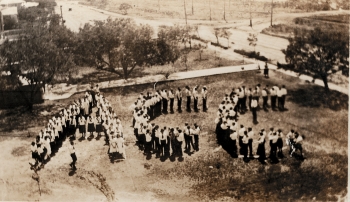

Continued Growth: A New Campus
The new (and current) campus opened in 1929.
Batsell Baxter became the young school's sixth president when Sewell resigned in 1924. Baxter initiated more relaxed restrictions on the social privileges of students, and student activities and organizations increased in importance.
Continued growth demanded more space, and in 1927 the Board of Trustees appointed a committee to explore new locations for the school. San Angelo made an attractive offer of two sections of land and $50,000 for building, to which the Abilene Chamber of Commerce responded by raising $75,000 to help keep the college from moving. With this contribution, the trustees decided to purchase 680 acres on a hill one mile northeast of Abilene that was part of the historic Hashknife Ranch. Nearby residents donated 75 additional acres.
The new campus opened Sept. 5, 1929, with eight structures: an administration building, two residence halls, an education building that housed the elementary and high schools, a dining hall, a gymnasium, an auditorium, and house for the president.
Enrollment Boom: Post-War Prosperity
A lower student population through World War II was followed by unprecedented enrollment increases after the war. Housing posed the biggest challenge. Barracks from nearby Camp Barkeley, deactivated by the U.S. Army in Spring 1946, were moved to the ACU Hill to house students and provide additional classroom and office space. The college was officially accredited Dec. 6, 1951, by the Southern Association of Colleges and Schools.
ACU surpassed the 2,000-student mark in 1955.
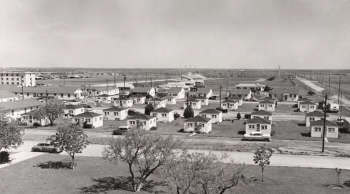
The post-war prosperity allowed several new buildings to be constructed to accommodate the increasing student body, which passed the 2,000 mark in 1955. Between 1940 and 1961, five residence halls, a science building, a president's home, a cafeteria and both wings of the Hardin Administration Building were completed.
In 1956, sophomore sprinter Bobby Morrow won three gold medals in track and field for the U.S. at the Olympic games in Melbourne, Australia. He received the Sullivan Award as the nation’s top amateur athlete and was named Sports Illustrated Sportsman of the Year. He also put ACU on the map as a track-and-field powerhouse.
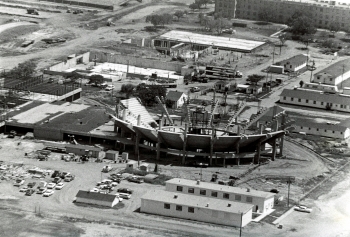
A Master Plan: Ambitious Design and Development
The Board of Trustees appointed a master planning council in 1958 "to study academic, financial and plant problems facing the college." In 1962, an ambitious Design for Development plan was adopted by the board. Over the next 19 years, this fundraising campaign generated more than $75 million in gifts, allowing for the construction of 15 new buildings and the renovation of 10 others, and the infusion of more than $25 million into the endowment. New buildings included Brown Library, McGlothlin Campus Center, Moody Coliseum, Gibson Health and Physical Education Center, Sherrod Residential Park, the Don H. Morris Center, A.B. Morris Hall, Smith-Adams Hall and Sikes Hall.
Over 19 years, ACU added 15 new buildings and renovated 10 -- and grew its endowment by $25 million.
Dr. John C. Stevens, historian, World War II chaplain and former Abilene City councilman, was named president in 1969, succeeding Dr. Don H. Morris, whose 29-year term was longer than any other Abilene Christian president. Stevens' 12-year presidency was marked by upgrades to campus housing, improvement in the college’s financial aid program for students, and more growth. The school had enrolled 3,000 for the first time in 1965, and it passed the 4,000 mark in 1977.
New Name, Same Mission: ACC becomes ACU
Abilene Christian College became a University in 1976.
ACC officially became ACU on Feb. 22, 1976, by a unanimous vote of the Board of Trustees. A committee chaired by trustee Jack Pope, chief justice of the Supreme Court of Texas, recommended the change. ACU's endowment grew from $18 million to $56 million in the 10-year presidency of Dr. William J. Teague, a former assistant to Morris and corporate executive who returned to ACU to succeed Stevens as president in 1981. The decade of the 1980s produced $78 million in gifts to the university, and Judge Ely Boulevard was moved east to accommodate construction of new buildings for the College of Business Administration and College of Biblical Studies.
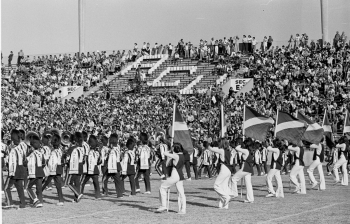
ACU helped form the intercollegiate Patty Hanks Shelton School of Nursing in 1981, and in 1986 the NPR affiliate KACU-FM was launched. The intercollegiate golf program was endowed in the name of former trustee and professional golf legend Byron Nelson. Intercollegiate baseball returned to campus when Crutcher Scott Field was built, thanks to fundraising efforts by major league baseball pitching legend Nolan Ryan.
Continued Growth: A Record Number of Students
Enrollment rebounded in the 1990s during the presidency of Dr. Royce Money, a Bible professor and licensed marriage and family therapist who took office June 1, 1991. ACU attracted students from all 50 states and 60 nations and endeavored to take its place as a national leader in Christian higher education.
To fund its growth in academic quality and image, serve its record numbers of students, and solidify its financial foundation, ACU received gifts in fundraising campaigns amounting to $30 million during Advancing the Changeless from 1993-96 and $114 million in To Lead and To Serve from 1996-2000.
Two major fundraising campaigns in the ’90s raised more than $144 million to support ACU’s vision for growth.
ACU began a semester-long World Class program in Oxford, England, in 1994 that later grew to year-round international residential learning centers at that location, plus Montevideo, Uruguay (1999), and Leipzig, Germany (2007), over the next two decades. Students are encouraged to spend one of their sophomore-year semesters in the university’s popular Study Abroad program.
In 1999, the Wildcat track and field program was named Texas Sports Dynasty of the Century by Texas Monthly magazine.
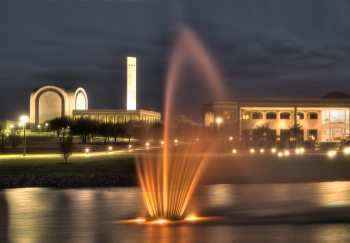
100 Years of ACU: Celebrating the Centennial
During the 2000-01 school year, a record 4,761 students enrolled, annual financial aid reached $40 million, and ACU ranked among the top 10 percent of institutions in the nation in endowment with $142 million. A record 943 bachelor's, master's and doctoral degrees were awarded at Commencements in May, August and December. Classes opened Jan. 13 in the new Williams Performing Arts Center, a $17 million facility with 92,000 square feet of space for the departments of music and theatre.
A record 943 degrees were awarded at the three 2001 Commencements.
ACU officially began its yearlong Centennial Celebration Aug. 22, 2005, with the Centennial Convocation. Events continued throughout the 100th school year as faculty, staff, students and alumni reflected on the university’s first century and looked ahead to a second.
Highlights of the Centennial included the unveiling of The ACU Century, a coffee-table book about the university's history; a Covenant Service; a Centennial Speaker Series that included Robin Roberts, Pat Summerall, Lester Holt and John Maxwell; the Centennial Historical Walking Tour, with exhibits around campus; a Centennial Pops Concert with the Abilene Philharmonic and vocalists featuring alumni professionals and students from the Department of Theatre; several academic conferences; presentation of more than 100 Change the World awards; an international Wildcat Week of Service at Spring Break; a Centennial Graduation Celebration with ACU alumnus and best-selling author Max Lucado as guest speaker; and the dedication of the Jacob’s Dream sculpture site.
Devices and Dedications: Investing in Innovation
In 2008, more than 900 entering freshmen received an Apple iPhone or iPod touch as part of the university's groundbreaking mobile-learning initiative. The students used the devices in and out of class to explore new ways of connecting learning to technology.
ACU's football team, led by head coach Chris Thomsen, won the Lone Star Conference championship in 2008 for the first time since 1973. Running back Bernard Scott won the Harlon Hill Trophy, the Division II version of the Heisman Trophy.
Dr. Royce Money retired in 2010 after 19 years of leading the university. Dr. Phil Schubert was inaugurated as the 11th president of Abilene Christian.
The 57,000-square-foot Hunter Welcome Center, named in honor of Dr. Bob Hunter and his wife, Shirley, was dedicated Feb. 21, 2009. In 2011, the 113,000-square-foot Royce and Pam Money Student Recreation and Wellness Center opened, providing fitness and leisure equipment, facilities and instruction to students, faculty and staff.
Brown Library was reimagined in 2006 when the Learning Commons was created on the main floor, and again in 2011 when the 8,800-square-foot AT&T Learning Studio opened as a place where media, mobility and the future of the academic library could be studied while helping students and faculty use the latest technology and tools.
Brown Library was reimagined when the 8,800-square-foot AT&T Learning Studio opened.
In 2012, ACU became one of only a few institutions worldwide to be named an Apple Distinguished School, a recognition by Apple as an exemplary learning environment for innovation, leadership and educational excellence. That designation was renewed in 2013 and 2014.
The university opened ACU at CitySquare, a learning center on North Akard Street in downtown Dallas, in 2012, partnering with the poverty-fighting enterprise formerly known as Central Dallas Ministries.
In 2013, ACU athletics moved from NCAA Division II to NCAA Division I, joining the Southland Conference — a respected league ACU helped found in 1963. Also in 2013, the first students enrolled in ACU’s new School of Nursing and the former Burford Music Center became the Phillips Education Building.
A $75 million Vision in Action initiative began in February 2014 to raise funds for three new science buildings and two stadiums. In April 2015, historic Elmer Gray Stadium was razed and a new Gray Stadium for track and field and soccer opened on the west side of campus. Bennett Gymnasium, one of the original structures at ACU when it moved to its hilltop campus in 1929, was renovated and opened in 2015 as laboratory space for the Department of Engineering and Physics.
ACU graduate Kent Brantly, M.D., in one of his first public speaking engagements since becoming the first American to be treated for Ebola on U.S. soil, spoke in Moody Coliseum on Oct. 10, 2014, joined by his wife, Amber. He was later profiled as one of “The Ebola Fighters” who appeared on the cover of Time magazine as 2014 Person of the Year.
On Oct. 30, 2015, the women's cross country team won ACU's first Southland Conference championship since moving to NCAA Division I.
Groundbreaking ceremonies took place Feb. 19, 2016, on Wildcat Stadium, the university's first on-campus venue for football games in more than 50 years. The first game on Anthony Field is scheduled to take place in Fall 2017.
The ACU Story Continues

21st Century Vision
Now that you've read about our past, here's a look at our future. We're proud of our 21st-Century Vision and our Strategic Plan, which build upon our core mission.

News at ACU
Our students, faculty, alumni and friends continue to add to our story with their discoveries, accomplishments and contributions.
